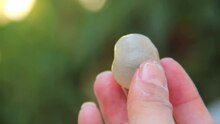Longan
| Longan | |
|---|---|
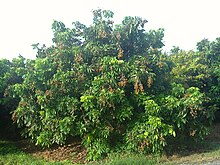
| |
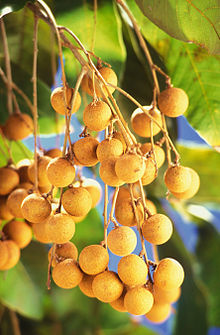
| |
| Longan fruit | |
| Scientific classification | |
| Kingdom: | Plantae |
| Clade: | Tracheophytes |
| Clade: | Angiosperms |
| Clade: | Eudicots |
| Clade: | Rosids |
| Order: | Sapindales |
| Family: | Sapindaceae |
| Genus: | Dimocarpus |
| Species: | D. longan
|
| Binomial name | |
| Dimocarpus longan | |
| Synonyms[2] | |
| |
| Longan | |||
|---|---|---|---|
 "Longan" in Traditional (top) and Simplified (bottom) Chinese characters | |||
| Traditional Chinese | 龍眼 | ||
| Simplified Chinese | 龙眼 | ||
| Literal meaning | 'dragon eye' | ||
| |||
Dimocarpus longan, commonly known as the longan (/ˈlɒŋɡən/), is a tropical tree species that produces edible fruit. It is one of the better-known tropical members of the soapberry family Sapindaceae, to which the lychee and rambutan also belong. The fruit of the longan is similar to that of the lychee, but less aromatic in taste.[3] It is native to tropical Asia and China.[4]
The longan (from Cantonese lùhng-ngáahn 龍眼, literally 'dragon eye'), is so named because it resembles an eyeball when its fruit is shelled (the black seed shows through the translucent flesh like a pupil/iris). The seed is small, round and hard, and of an enamel-like, lacquered black. The fully ripened, freshly harvested fruit has a bark-like shell, thin, and firm, making the fruit easy to peel by squeezing the pulp out as if one were "cracking" a sunflower seed. When the shell has more moisture content and is more tender, the fruit becomes less convenient to shell. The tenderness of the shell varies due to either premature harvest, variety, weather conditions, or transport/storage conditions.
Subspecies[]
Plants of the World Online[5] lists:
- D. longan var. echinatus Leenhouts (Borneo, Philippines)
- D. longan var. longetiolatus Leenhouts (Viet Nam)
- D. longan subsp. malesianus Leenh. (widespread SE Asia)
- D. longan var. obtusus (Pierre) Leenh. (Indo-China)
Tree description[]
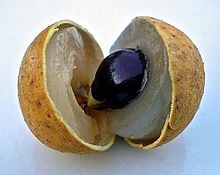
Depending upon climate and soil type the tree may grow to over 100 feet (30 m)[6] in height, but it typically stands 30–40 ft (9–12 m) in height[7] and the crown is round.[8] The trunk is 2.5 ft (0.8 m) thick[7] with corky bark.[8] The branches are long and thick, typically drooping.[7]
The leaves are oblong and blunt-tipped, usually 4–8 inches (10–20 cm) long and 2 in (5 cm) wide.[7] The leaves are pinnately compounded and alternate.[8] There are 6 to 9 pairs of leaflets per leaf[8] and the upper surface is wavy and a dark, glossy-green.[7]
The longan tree produces light-yellow inflorescences at the end of branches.[7] The inflorescence is commonly called a panicle and are 4–18 in (10–46 cm) long, and widely branched.[8] The small flowers have 5 to 6 sepals and petals that are brownish-yellow.[8] The flower has a two-lobed pistil and 8 stamen. There are three flower types, distributed throughout the panicle;[7] staminate (functionally male), pistillate (functionally female), and hermaphroditic flowers.[8] Flowering occurs as a progression.[8]
The fruit hangs in drooping clusters that are circular and about 1 in (2.5 cm) wide. The peel is tan, thin, and leathery with tiny hairs.[8] The flesh is translucent, and the seed is large and black with a circular white spot at the base.[7][8] This gives the illusion of an eye.[7] The flesh has a musky, sweet taste, which can be compared to the flavor of lychee fruit.[7]
The longan tree is somewhat sensitive to frost. Longan trees prefer sandy soil. While the species prefers temperatures that do not typically fall below 4.5 °C (40 °F), it can withstand brief temperature drops to about −2 °C (28 °F).[9] Longans usually bear fruit slightly later than lychees.[10]
The wild longan population have been decimated considerably by large-scale logging in the past, and the species used to be listed as Vulnerable on the IUCN Red List. If left alone, longan tree stumps will resprout and the listing was upgraded to Near Threatened in 1998. Recent field data are inadequate for a contemporary IUCN assessment.[1]
History[]
The longan is believed to originate from the mountain range between Myanmar and southern China. Other reported origins include India, Sri Lanka, upper Myanmar, north Thailand, Kampuchea (more commonly known as Cambodia), north Vietnam and New Guinea.[11]
Its earliest record of existence draws back to the Han dynasty in 200 BC. The emperor had demanded lychee and longan trees to be planted in his palace gardens in Shaanxi, but the plants failed. Four hundred years later, longan trees flourished in other parts of China like Fujian and Guangdong, where longan production soon became an industry.[12]
Later on, due to immigration and the growing demand for nostalgic foods, the longan tree was officially introduced to Australia in the mid-1800s, Thailand in the late-1800s, and Hawaii and Florida in the 1900s. The warm, sandy-soiled conditions allowed for the easy growth of longan trees. This jump-started the longan industry in these locations.[12]
Despite its long success in China, the longan is considered to be a relatively new fruit to the world. It has only been acknowledged outside of China in the last 250 years.[12] The first European acknowledgment of the fruit was recorded by Joao de Loureiro, a Portuguese Jesuit botanist, in 1790. The first entry resides in his collection of works, Flora Cochinchinensis.[3]
Currently, longan crops are grown in southern China, Taiwan, northern Thailand, Malaysia, Indonesia, Cambodia, Laos, Vietnam, India, Sri Lanka, Philippines, Australia, the United States, and Mauritius.[11] It is also grown in Bangladesh.[13]
Culinary uses[]
The fruit is sweet, juicy, and succulent in superior agricultural varieties. The seed and the peel are not consumed. Apart from being eaten raw like other fruits, longan fruit is also often used in Asian soups, snacks, desserts, and sweet-and-sour foods, either fresh or dried, and sometimes preserved and canned in syrup. The taste is different from lychees; while longan has a drier sweetness similar to dates, lychees are often messily juicy with a more tropical, grape-like sour sweetness.
Dried longan are often used in Chinese cuisine and Chinese sweet dessert soups. In Chinese food therapy and herbal medicine, it is believed to have an effect on relaxation.[14] In contrast with the fresh fruit, which is juicy and white, the flesh of dried longans is dark brown to almost black.
Nutrition[]
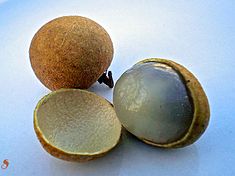 A peeled longan fruit | |
| Nutritional value per 100 g (3.5 oz) | |
|---|---|
| Energy | 251 kJ (60 kcal) |
15.14 g | |
| Sugars | n/a |
| Dietary fiber | 1.1 g |
0.1 g | |
1.31 g | |
| Threonine | 0.034 g |
| Isoleucine | 0.026 g |
| Leucine | 0.054 g |
| Lysine | 0.046 g |
| Methionine | 0.013 g |
| Phenylalanine | 0.030 g |
| Tyrosine | 0.025 g |
| Valine | 0.058 g |
| Arginine | 0.035 g |
| Histidine | 0.012 g |
| Alanine | 0.157 g |
| Aspartic acid | 0.126 g |
| Glutamic acid | 0.209 g |
| Glycine | 0.042 g |
| Proline | 0.042 g |
| Serine | 0.048 g |
| Vitamins | Quantity %DV† |
| Thiamine (B1) | 3% 0.031 mg |
| Riboflavin (B2) | 12% 0.14 mg |
| Niacin (B3) | 2% 0.3 mg |
| Vitamin C | 101% 84 mg |
| Minerals | Quantity %DV† |
| Calcium | 0% 1 mg |
| Iron | 1% 0.13 mg |
| Magnesium | 3% 10 mg |
| Manganese | 2% 0.052 mg |
| Phosphorus | 3% 21 mg |
| Potassium | 6% 266 mg |
| Sodium | 0% 0 mg |
| Zinc | 1% 0.05 mg |
| Other constituents | Quantity |
| Water | 83 g |
| |
| †Percentages are roughly approximated using US recommendations for adults. Source: USDA FoodData Central | |
Raw longan fruit is 83% water, 15% carbohydrates, 1% protein, and contains negligible fat. In a 100 gram reference amount, raw longan supplies 60 calories of food energy, 101% of the Daily Value (DV) of vitamin C, 12% DV of riboflavin, and no other micronutrients in appreciable quantities (table).
Traditional medicine[]
Longan may be used in traditional Eastern folk medicine. Prior to the 1800s, longan was prevalent in Asia.[12]
In ancient Vietnamese medicine, the "eye" of the longan seed was pressed against snakebites to absorb the venom. This was ineffective, but may still be used in the 21st century.[15]
Cultivation, harvest and distribution[]
It is found commonly in most of Asia, primarily in mainland China, Taiwan, Vietnam and Thailand. China, the main longan-producing country in the world, produced about 1,900 thousand tonnes of longan in 2015–2017. Vietnam and Thailand produced around 500 thousand and 980 thousand tonnes, respectively.[16] Like Vietnam, Thailand's economy relies heavily on the cultivation and shipments of longan as well as lychee. This increase in the production of longan reflects recent interest in exotic fruits in other parts of the world. However, the majority of the demand comes from Asian communities in North America, Europe and Australia.[12]
The longan industry is very new in North America and Australia. Commercial crops have only been around for twenty years. In the United States, longan is grown in Florida, Texas, Nevada, Georgia, California, Hawaii, and Arizona. They are also grown in Australia, along the eastern coast.
During harvest, pickers must climb ladders to carefully remove branches of fruit from longan trees. Longan fruit remain fresher if still attached to the branch, so efforts are made to prevent the fruit from detaching too early. Mechanical picking would damage the delicate skin of the fruit, so the preferred method is to harvest by hand. Knives and scissors are the most commonly used tools.[17]
Fruit is picked early in the day to minimize water loss and to prevent high heat exposure, which would be damaging. The fruit is then placed into either plastic crates or bamboo baskets and taken to packaging houses, where the fruit undergo a series of checks for quality. The packaging houses are well-ventilated and shaded to prevent further decay. The process of checking and sorting are performed by workers instead of machinery. Any fruit that is split, under-ripe, or decaying is disposed of. The remaining healthy fruit is then prepped and shipped to markets.[12]
Many companies add preservatives to canned longan. Regulations control the preserving process. The only known preservative added to canned longan is sulfur dioxide, to prevent discoloration.[12] Fresh longan that is shipped worldwide is exposed to sulfur fumigation. Tests have shown that sulfur residues remain on the fruit skin, branches, and leaves for a few weeks. This violates many countries' limits on fumigation residue, and efforts have been made to reduce this amount.[12]
Gallery[]

Longan (Dimocarpus longan) tree leaves
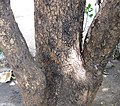
Longan tree lower trunk

The longan was described in Joao de Loureiro's work, Flora Cochinchinensis, published in 1790
References[]
- ^ Jump up to: a b "Dimocarpus longan". IUCN Red List of Threatened Species. IUCN. 1998: e.T32399A9698234. 1998. doi:10.2305/IUCN.UK.1998.RLTS.T32399A9698234.en.
- ^ Jump up to: a b "Dimocarpus longan". World Checklist of Selected Plant Families (WCSP). Royal Botanic Gardens, Kew. Retrieved 5 September 2016 – via The Plant List.
- ^ Jump up to: a b Pham, V.T.; Herrero, M. (2016). "Fruiting pattern in longan, Dimocarpus longan: from pollination to aril development" (PDF). Annals of Applied Biology. 169 (3): 357–368. doi:10.1111/aab.12306. hdl:10261/135703.
- ^ "Dimocarpus longan". Germplasm Resources Information Network (GRIN). Agricultural Research Service (ARS), United States Department of Agriculture (USDA). Retrieved 11 December 2017.
- ^ "Dimocarpus longan Lour. | Plants of the World Online | Kew Science". Plants of the World Online.
- ^ Crane, Jonathan H.; Balerdi, Carlos F.; Sargent, Steven A.; Maguire, Ian (November 1978). "Longan Growing in the Florida Home Landscape". University of Florida (2016 ed.). Retrieved 4 April 2017.
- ^ Jump up to: a b c d e f g h i j Morton, Julia F. (1987). Fruits of warm climates. W. Lafayette, IN, USA: NewCrop, Center for New Crops and Plant Products, Department of Horticulture and Landscape architecture at Purdue University. pp. 259–262.
- ^ Jump up to: a b c d e f g h i j Crane, Jonathan; Balerdi, Carlos; Sarge, Steven; Maguire, Ian (2015). "Longan Growing in the Florida Home Landscape". IFAS University of Florida. Retrieved 5 April 2017.
- ^ Herbst, S. & R. (2009). The Deluxe Food Lover's Companion. Barron's Educational Series – via Credo Reference.
- ^ Jiang, Yueming; Zhang, Zhaoqi (November 2002). "Postharvest biology and handling of longan fruit (Dimocarpus longan Lour.)". Postharvest Biology and Technology. 26 (3): 241–252. doi:10.1016/s0925-5214(02)00047-9.
- ^ Jump up to: a b Lim, T.K. (2013). "Dimocarpus longan subsp. longan var. longan". Edible Medicinal And Non-Medicinal Plants: Volume 6, Fruits. Springer Science & Business Media. pp. 18–29. ISBN 978-94-007-5628-1.
- ^ Jump up to: a b c d e f g h Menzel, C.; Waite, G.K.; Mitra, S.K. (2005). Litchi and Longan: Botany, Production and Uses. CAB International. ISBN 9781845930226 – via ProQuest ebrary.
- ^ Khatun, MM; Karim, MR; Molla, MM; Khatun, MM; Rahman, MJ (2012). "Study on the physico-chemical characteristics of longan (Euphoria longana) germplasm". Bangladesh Journal of Agricultural Research. 37 (3): 441–447. doi:10.3329/bjar.v37i3.12087. ISSN 0258-7122.
- ^ Teeguarden, Ron. "Tonic Herbs That Every Qigong Practioner [sic] Should Know, Part 2". Qi Journal.
- ^ Small, Ernest (2011). Top 100 Exotic Food Plants. CRC Press – via Google Books.
- ^ Altendorf, Sabine (July 2018). "MINOR TROPICAL FRUITS Mainstreaming a niche market" (PDF). FAO. Retrieved 9 September 2020.
- ^ Siddiq, Muhammad (2012). Tropical and Subtropical Fruits: Postharvest Physiology, Processing and Packaging. John Wiley & Sons – via Google Books.
External links[]
- Longan Production in Asia from the Food and Agriculture Organization of the United Nations
| Wikimedia Commons has media related to Dimocarpus longan. |
| Wikispecies has information related to Dimocarpus longan. |
- IUCN Red List near threatened species
- Cantonese cuisine
- Chinese fruit
- Dimocarpus
- Edible fruits
- Flora of tropical Asia
- Fruits originating in East Asia
- Han dynasty
- Indomalayan realm flora
- Near threatened plants
- Plants described in 1790
- Traditional Chinese medicine
- Trees of China
- Tropical fruit

